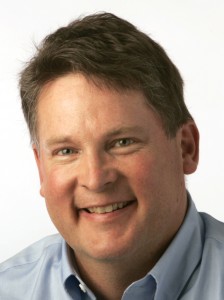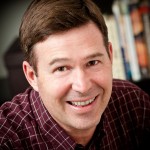The scheming killer is back, still fixated on the young woman reporter.
But this time he isn’t prepared for how his murders will put her in harm’s way.
Fourteen chapters.
Fourteen writers.
One thriller.
Click here to read Season One: The Sonoma Squares Murder Mystery.
PREVIOUSLY: The home invasion robbers plan to get their money back by using Sandra as bait.
Chapter 10 – The Mentor
By PAUL GULLIXSON
As Detective Brown surrendered his sidearm, a Glock 17, and handcuffs at the security desk at Cell Block North, he was reminded of his first impressions of “the Big House.” To police academy cadets, San Quentin State Prison was the infrastructure of success. It was the end. The terminus of good police work. It was only later he realized how flawed that vision was.
Nothing came to an end at San Quentin. On the contrary, everything continued: The crime, the violence. Even the drug use. For many, a trip to the House was in fact more of a beginning, a start of something far worse.
Even here on Death Row there was no end, no death. Not really. It galled Brown no end that since 1978 cops, good cops, had put roughly 900 killers on Death Row in California. But since then, only 14 had been executed and none in seven years. These creeps were ten times more likely to die of old age than breathe their last by lethal injection. Instead they were allowed to live out their days on some of the most expensive real estate in all the West Coast. What a waste. A waste of land and time.
Nonetheless, that day there was one inmate that Brown was gratified had not met his end.
It was the smile he recognized first. Marcel James Howland was older and grayer. But the smile was unmistakable. He still had that toothy grin – the same one that was flashed on so many TV screens the day of his conviction. He had smiled and waved as he was led away, a move that had offended many people, given the heinousness of his murders.
“Mr. Detective, it’s nice you came all this way, but like I told you in my letter, you is wasting your time,” the prisoner said, as he sat on a stool, his hands still shackled. He was allowed only non-contact visits, meaning a glass partition separated him from anyone who bothered to visit. Few ever did.
Brown looked him over. As he did, he remembered Abby, who had first told Sandra Cordero and him about the link between Howland and the man who might be the Sonoma Squares Killer. Abby felt sure the inmate held the key to this case.
“Marcel,” said Brown. “You told me that Gerald Mark Pointer had come out to talk only about a half-dozen times. But I checked the logs, and you lied to me. In fact, he visited you 53 times over two years.”
There was a pause. “Now, Detective . . .”
“Marcel, don’t BS me,” snapped Brown. “I know you were just given permission to take a class. Something you’ve been wanting for a long time. Philosophy, isn’t it? I would hate for you to lose that privilege. But that’s an option if you continue to lie to me.”
Marcel looked down. “What did the kid do?” he asked.
“I bet you can guess. How ‘bout if you help me a little?”
“Help you?” Howland said, first with a laugh and then an expletive. “I can’t help you. But I will tell you one thing. That kid is broke. Like a clock whose hands keep moving but after a while you realize that something ain’t right because what that clock is telling you and what’s real ain’t the same thing.”
“So why did you spend so much time with him?”
“Pointer?” Howland smiled. “He was all right. He used to sit right where you are. Said he had to write everything down because they wouldn’t let him bring in a tape recorder. He was working on a master’s project. A thesis. I didn’t mind cause each time he came he bought me things. Soda, peanuts, things like that. No, I didn’t mind. We would just talk. And then one day I noticed he wasn’t taking notes no more. He was just listening.”
“And what did you tell him?”
“Now you don’t expect me to remember all the things we talked about.”
“Did you talk about his parents?”
“Yes.”
“What did he say?” Brown pressed.
“Mr. Detective, you’re smart enough to know that if someone is broke it’s usually because someone messed with the internal workings. And it’s usually the parents that do the tinkering. Pointer’s family broke him with all that talk about ADHD and crap like that. And all those medications. That stuff messed him up. I was just trying to help him put some pieces back together and man up for a change.”
“You were fixing him? How?”
Howland broke into that awful grin. “People like you, you don’t understand the power of hate. It can cure things. Hate was the only way he was going to survive. At first, he kept listening to the people who were breaking him, especially when they told him to stay away from that girl he was sopping over. Even so, he kept talking about how she was going to be somebody special one day, but his folks couldn’t see it. He wanted to get off the meds and show her who he really was. He dwelled on that one. But some people kept hating on him, detective, and they wouldn’t let him be. That’s when he started to understand the power of hate.”
“And then they died,” said Brown, as if reciting the last line in a bad play.
“Yeah, and then they died.”
“Some say his parents just lost control of the car and went over the side of the coast highway,” Brown said. “But a bartender at a joint near the crash swore he heard an explosion first and then the squeal of tires.”
“I guess that’s so,” Howland offered.
“Did he kill them?”
The prisoner said nothing.
“In the article for his master’s project, Pointer called you his mentor. Why was that?”
“I told you detective, I just tried to help him put some pieces back together.”
“I’m told you’re handy with putting things together, Marcel. Wiring cars. Programming computers, lots of stuff. You also were pretty handy at making things come apart”
Howland shrugged.
“Now that I think of it, two of the women that you were suspected of killing died in similar accidents. Explosions, right?”
“Officer, that’s tired ground. Give it a rest. Investigators found that woman was on her car phone. You text, you drive, you die. It’s as simple as that. The other just fell asleep or something. No car phone. Don’t pin those on me. Flawed people sometimes come with tragic ends,” he added. “Fiery finishes. We should all have such a fiery finish.”
“Fat chance of that for some of us,” Brown groused, as he got up and left.
“Car phone,” he muttered outside the prison walls as he got into his car. “I’ve heard those words before, right after a big bang.” He stepped on the accelerator, determined to track down Gerald Mark Pointer.

Paul Gullixson is the editorial director at The Press Democrat.
TO SEE ALL THE SONOMA SQUARES WRITERS AND THEIR CHAPTERS, WHEN PUBLISHED, CLICK HERE.
Edited by ROBERT DIGITALE and FREDERICK WEISEL
A PROJECT OF SONOMA WRITERS
Connecting Readers and Writers
Find us on Facebook. Click here.


